How Data-Informed Instructional Coaching Programs Support Teachers and Improve Academic Outcomes
Key Points
-
In the 2022 Coaching Impact Report, 81% of districts reported that they do not have the data or tools to measure the time, effort, and impact of their teacher coaching programs.
-
Access to instructional coaching data is critical, especially as teachers work towards rebuilding their classrooms and supporting students impacted by pandemic learning disruptions.

By: Jason DeRoner
Issues with teacher retention and shortages are having serious negative consequences for students and educators. When teachers are dissatisfied with their work environments and aren’t receiving adequate support, it can impact their students’ academic progress and overall school experience. This academic year, teachers are facing a variety of challenges as they work to help students recover from the pandemic’s impacts on learning. It is more critical than ever that districts identify ways to retain and support quality teachers. Instructional coaching is a vital piece of the puzzle. While coaching can be an effective strategy to support teachers and improve academic outcomes, it needs to be informed by data to really ensure it’s having the desired impact.
TeachBoost recently surveyed educators from 86 different school districts across a variety of roles, experience levels, and grade levels to find out what’s working, what’s not, and what should change about instructional coaching programs. The findings were released in the 2022 Coaching Impact Report. This new national report offers valuable insights and takeaways to help district leaders and educators build quality coaching programs.
Leaders Need Access to Data
Every student deserves an excellent education and a teacher who is properly supported. Coaching can help ensure that high-quality, equitable instruction is reaching more classrooms — but leaders need access to data to prove it’s working.
One common challenge that surfaced from the report is that many leaders and coaches aren’t able to prove the impact of their coaching programs. The report revealed that while most districts (79%) use metrics to measure student mastery, achievement, and outcomes, 81% of schools and districts surveyed do not have the data or tools to measure the time, effort, and impact of their coaching programs.
This reflects exactly what I have seen in my work with schools over the past 12 years. Having data on coaching programs has become even more important now as districts are looking for effective ways to close learning gaps that are disproportionately impacting some of our most underserved students. Leaders want evidence that shows that investing in their coaching program is making a difference in teacher retention and student outcomes.
The report showed that most respondents (78%) agreed that districts with access to real-time, aggregated coaching data aligned to instructional goals can make more proactive and informed decisions about how to improve instruction. Yet, only 21% of respondents say they always use data to drive coaching decisions, and 57% say they often use data but would like to have more. Among school leaders, most (81%) shared that they want to use coaching data to make decisions but they don’t have access to the right data to make informed decisions.
Many districts (63%) are still using pen and paper to track coaching work which is part of the reason why the impact of their programs isn’t being fully measured. Without the right systems in place, coaches are often left to cobble together their own ways to organize and share their work, preventing district leaders from having easy access to the data and stories that show how instructional coaching aligns with strategic and professional development priorities.
Coaching data is vital for building sustainable, effective coaching programs.
Jason DeRoner
How Having Coaching Data Helps Districts
Over the years, I have had the opportunity to work directly with district leaders like Brandon White, an assistant superintendent of academics in South Bend, Indiana. I’ve seen first-hand Brandon’s progress as he’s built a strong and data-driven coaching program from the ground up. The instructional coaching program is part of the district’s strategy for increasing literacy rates. Brandon believes that coaches are vital for supporting teachers in the classroom, but he knows that just having coaches isn’t enough. He wanted real-time data to show the effectiveness of the district’s coaching program so that he and his team could make decisions and prove the value of the district’s investment. When he came to us, he needed the tools to build a coaching program he could measure.
Brandon wants to see how adult learning activities align with the district’s strategic and professional development priorities through real-time data and stories. “When you have access to data about coaching activity, you can measure the effectiveness of your coaching program against district goals and mandates,” shared Brandon. “Aggregated data helps us make decisions about what’s working and where support is needed so that we can defend and grow our program.”
It’s Not Enough to Just Put a Coach in the Classroom
The pandemic has accelerated many of the trends we’re seeing in instructional coaching and underscored the need for urgent change. Teacher retention and burnout continue to be problems for districts, and many leaders are looking to instructional coaching programs as part of their strategy to better support teachers and students.
The majority of the educators that we surveyed see the connection between coaching, teacher growth, and student achievement, but don’t have concrete evidence to prove it. The urgency is greater than ever as districts need immediate solutions to the unprecedented challenges they face. Coaches can provide much-needed support for teachers as they work to help students who have been severely impacted by years of pandemic disruptions.
It’s not enough to just put a coach in the classroom. Coaches must have the tools they need to do their work and leaders need data and stories to measure the impact of their coaching programs so that they can make faster, more informed decisions and direct their investments of time and money in the areas that will have the greatest impact on teaching and learning.
Jason DeRoner is the CEO and Co-Founder of TeachBoost.




0 Comments
Leave a Comment
Your email address will not be published. All fields are required.